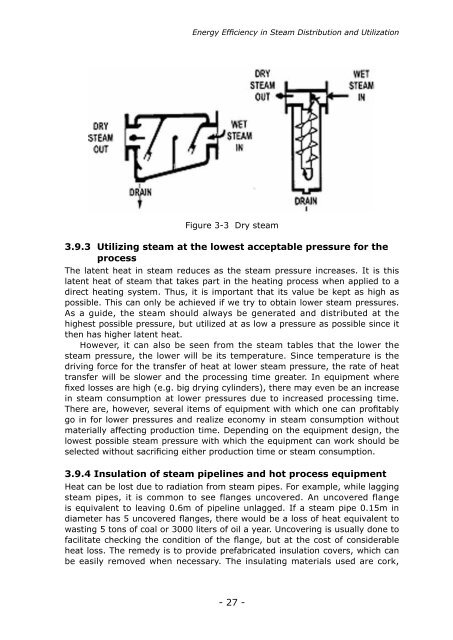Training Manual on Energy Efficiency - APO Asian Productivity ...
Training Manual on Energy Efficiency - APO Asian Productivity ...
Training Manual on Energy Efficiency - APO Asian Productivity ...
You also want an ePaper? Increase the reach of your titles
YUMPU automatically turns print PDFs into web optimized ePapers that Google loves.
<strong>Energy</strong> <strong>Efficiency</strong> in Steam Distributi<strong>on</strong> and Utilizati<strong>on</strong><br />
Figure 3-3 Dry steam<br />
3.9.3 Utilizing steam at the lowest acceptable pressure for the<br />
process<br />
The latent heat in steam reduces as the steam pressure increases. It is this<br />
latent heat of steam that takes part in the heating process when applied to a<br />
direct heating system. Thus, it is important that its value be kept as high as<br />
possible. This can <strong>on</strong>ly be achieved if we try to obtain lower steam pressures.<br />
As a guide, the steam should always be generated and distributed at the<br />
highest possible pressure, but utilized at as low a pressure as possible since it<br />
then has higher latent heat.<br />
However, it can also be seen from the steam tables that the lower the<br />
steam pressure, the lower will be its temperature. Since temperature is the<br />
driving force for the transfer of heat at lower steam pressure, the rate of heat<br />
transfer will be slower and the processing time greater. In equipment where<br />
fixed losses are high (e.g. big drying cylinders), there may even be an increase<br />
in steam c<strong>on</strong>sumpti<strong>on</strong> at lower pressures due to increased processing time.<br />
There are, however, several items of equipment with which <strong>on</strong>e can profitably<br />
go in for lower pressures and realize ec<strong>on</strong>omy in steam c<strong>on</strong>sumpti<strong>on</strong> without<br />
materially affecting producti<strong>on</strong> time. Depending <strong>on</strong> the equipment design, the<br />
lowest possible steam pressure with which the equipment can work should be<br />
selected without sacrificing either producti<strong>on</strong> time or steam c<strong>on</strong>sumpti<strong>on</strong>.<br />
3.9.4 Insulati<strong>on</strong> of steam pipelines and hot process equipment<br />
Heat can be lost due to radiati<strong>on</strong> from steam pipes. For example, while lagging<br />
steam pipes, it is comm<strong>on</strong> to see flanges uncovered. An uncovered flange<br />
is equivalent to leaving 0.6m of pipeline unlagged. If a steam pipe 0.15m in<br />
diameter has 5 uncovered flanges, there would be a loss of heat equivalent to<br />
wasting 5 t<strong>on</strong>s of coal or 3000 liters of oil a year. Uncovering is usually d<strong>on</strong>e to<br />
facilitate checking the c<strong>on</strong>diti<strong>on</strong> of the flange, but at the cost of c<strong>on</strong>siderable<br />
heat loss. The remedy is to provide prefabricated insulati<strong>on</strong> covers, which can<br />
be easily removed when necessary. The insulating materials used are cork,<br />
- 27 -
















